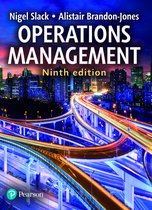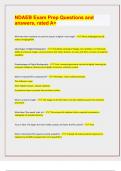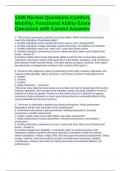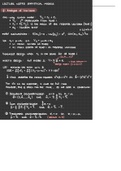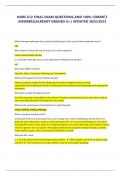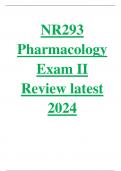Chapter 8 Process Technology
What is process technology and why is it getting more important?
The idea of harnessing technology to make operations more effective is not new. What is new, is the
sheer scope, sophistication and combination of technologies that are being deployed or developed
to be part of operations activities in almost all parts of the economy. The most important implication
is the rate and extent of change that operations managers will have to cope with.
Process technology versus product technology
Technology: the application of scientific knowledge for practical purposes, especially in
industry.
In manufacturing operations, it is relatively simple to separate process technology from product or
service technology. In service operations this can be far more difficult.
Process technology: the machines, equipment, and devices that create and/or deliver
products and services.
Process technology has a very significant effect on quality, speed, dependability, flexibility and cost.
Even when technology seems peripheral to the actual creation of goods and services, it can play a
key role in facilitating the direct transformation of inputs to an operation.
Indirect process technology: technology that helps managers and operators control and
improve the processes.
What is one business’s product/service technology is another’s process technology.
What is ‘new’ in new technologies?
Most new process technologies have a greater capability than what they are replacing; in other
words, new process technologies are capable of doing things that older technologies couldn’t do, or
do as well.
These increased capabilities have a greater scope of application; they can be applied in sectors of the
economy, and in types of operation, where process technology used to be far less important.
New technologies often have increased capabilities
Some technologies are becoming less expensive. Technologies combined with artificial intelligence
can perform activities previously presumed to require expert human judgement. Labor substitution
accounts for some of the motive for adopting new technologies.
New technologies can increasingly be applied in all types of operation
There used to be a simple division between those operations that used a lot of process technology
and those that used little or no process technology. But this is no longer true. The scope and
capabilities of so many technologies have expanded to the point where there are very few, if any,
types of enterprises that are not actively using some kind of technology to support their operations
processes.
Process technology and transformed resources
One common method of distinguishing between different types of process technology is by what the
technology actually processes – materials, information or customers.
Material-processing technologies
, These include any technology that shapes, transports, stores, or in any way changes physical objects.
In manufacturing operations, technological advances have meant that the ways in which metals,
plastics, fabric and other materials are processed have improved over time. Generally, it is the initial
forming and shaping of materials at the start, and the handling and movement through the supply
network that has been most affected by technology advances.
Information-processing technology
Information-processing technology, or just information technology (IT), is the most common single
type of technology within operations, and includes any device which collects, manipulates, stores or
distributes information. Other types of information-processing technologies came to provide
opportunities for process innovation, particularly those involving some form of analytical capability,
such as algorithmic decision making, artificial intelligence (AI) and data mining, those involving
communication or connectivity, such as blockchain, and those capable of processing visual
information, such as augmented reality (AU).
Customer-processing technology
Although customer-processing operations were once seen as ‘low-technology’, now process
technology is very much in evidence in many services. There are three types of customer-processing
technologies:
1. Active interaction technology such as automobiles, online shopping, fitness equipment and
self-checkout stations.
2. Passive interactive technology such as aircraft, mass transport systems, moving walkways,
elevators, cinemas, ‘fitness’ monitors and most theme park rides.
3. Hidden technology such as security monitoring, face recognition technologies in shopping
malls or at national frontier customs areas.
Integrating technologies
Integrating technologies: technologies that process more than one type of resource, and/or
are combinations of other technologies.
How should operations managers manage process technology?
- They need to understand the technology to the extent that they are able to articulate what
it should be able to do; not in the sense that they need to be experts in whatever constitutes
the core science of the technology, but enough to understand its implications.
- They should be able to evaluate alternative technologies, particularly as they affect the
operations they manage, and share in the decisions of which technology to choose.
- They must be able to manage – that is, develop, plan and implement – the technology so
that it can reach its full potential in contributing to the performance of the operation as a
whole.
What is process technology and why is it getting more important?
The idea of harnessing technology to make operations more effective is not new. What is new, is the
sheer scope, sophistication and combination of technologies that are being deployed or developed
to be part of operations activities in almost all parts of the economy. The most important implication
is the rate and extent of change that operations managers will have to cope with.
Process technology versus product technology
Technology: the application of scientific knowledge for practical purposes, especially in
industry.
In manufacturing operations, it is relatively simple to separate process technology from product or
service technology. In service operations this can be far more difficult.
Process technology: the machines, equipment, and devices that create and/or deliver
products and services.
Process technology has a very significant effect on quality, speed, dependability, flexibility and cost.
Even when technology seems peripheral to the actual creation of goods and services, it can play a
key role in facilitating the direct transformation of inputs to an operation.
Indirect process technology: technology that helps managers and operators control and
improve the processes.
What is one business’s product/service technology is another’s process technology.
What is ‘new’ in new technologies?
Most new process technologies have a greater capability than what they are replacing; in other
words, new process technologies are capable of doing things that older technologies couldn’t do, or
do as well.
These increased capabilities have a greater scope of application; they can be applied in sectors of the
economy, and in types of operation, where process technology used to be far less important.
New technologies often have increased capabilities
Some technologies are becoming less expensive. Technologies combined with artificial intelligence
can perform activities previously presumed to require expert human judgement. Labor substitution
accounts for some of the motive for adopting new technologies.
New technologies can increasingly be applied in all types of operation
There used to be a simple division between those operations that used a lot of process technology
and those that used little or no process technology. But this is no longer true. The scope and
capabilities of so many technologies have expanded to the point where there are very few, if any,
types of enterprises that are not actively using some kind of technology to support their operations
processes.
Process technology and transformed resources
One common method of distinguishing between different types of process technology is by what the
technology actually processes – materials, information or customers.
Material-processing technologies
, These include any technology that shapes, transports, stores, or in any way changes physical objects.
In manufacturing operations, technological advances have meant that the ways in which metals,
plastics, fabric and other materials are processed have improved over time. Generally, it is the initial
forming and shaping of materials at the start, and the handling and movement through the supply
network that has been most affected by technology advances.
Information-processing technology
Information-processing technology, or just information technology (IT), is the most common single
type of technology within operations, and includes any device which collects, manipulates, stores or
distributes information. Other types of information-processing technologies came to provide
opportunities for process innovation, particularly those involving some form of analytical capability,
such as algorithmic decision making, artificial intelligence (AI) and data mining, those involving
communication or connectivity, such as blockchain, and those capable of processing visual
information, such as augmented reality (AU).
Customer-processing technology
Although customer-processing operations were once seen as ‘low-technology’, now process
technology is very much in evidence in many services. There are three types of customer-processing
technologies:
1. Active interaction technology such as automobiles, online shopping, fitness equipment and
self-checkout stations.
2. Passive interactive technology such as aircraft, mass transport systems, moving walkways,
elevators, cinemas, ‘fitness’ monitors and most theme park rides.
3. Hidden technology such as security monitoring, face recognition technologies in shopping
malls or at national frontier customs areas.
Integrating technologies
Integrating technologies: technologies that process more than one type of resource, and/or
are combinations of other technologies.
How should operations managers manage process technology?
- They need to understand the technology to the extent that they are able to articulate what
it should be able to do; not in the sense that they need to be experts in whatever constitutes
the core science of the technology, but enough to understand its implications.
- They should be able to evaluate alternative technologies, particularly as they affect the
operations they manage, and share in the decisions of which technology to choose.
- They must be able to manage – that is, develop, plan and implement – the technology so
that it can reach its full potential in contributing to the performance of the operation as a
whole.

